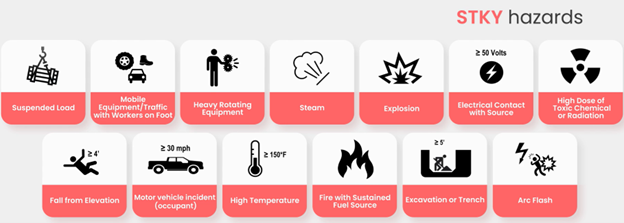Information provided by the Construction Safety Resource Alliance (CSRA)
High Energy Control Assessments (HECA) is a new method of measuring safety performance that evaluates the extent to which front line workers are protected from life threatening hazards. HECA is calculated as a percentage of high-energy hazards with a corresponding direct control. By applying a precise definition of high energy hazard and direct control, we can ensure that assessments are valid and comparable across companies.
HECA can be measured through three steps which can be performed on site visits:
Step 1: Identify high energy hazards. High energy hazards are those with enough energy that a serious injury or fatality is the most likely outcome if contacted. To facilitate assessment, icons were created to identify the 13 most common high energy hazards. In the field, these are referred to as the stuff that kills you or STKY hazards.
Step2: Assess whether each high energy hazard identified has a corresponding direct control at the time of assessment. To be considered a direct control, and sufficient to protect against a life-threatening hazard, a safeguard must meet all the following criteria:
- The control is specifically targeted at the high energy hazard.
- The control effectively mitigates exposure to high-energy.
- The control is effective even when someone makes a mistake.
High energy hazards with a direct control are marked as a success and those without a direct control are marked as an exposure.
Step 3: Complete the HECA score by dividing the total number of successes (high energy hazards identified with a direct control) by the total number of high energy hazards observed (success + exposure).
With this equation, we have effectively measured the number of success conditions observed during our site visit.
HECA is distinguished by some important features:
- HECA is based on the science of energy-based safety and the principles of human and organizational performance.
- HECA operationalizes the idea that safety is the presence of safeguards, not the absence of injuries.
- HECA recognizes that even the best people make mistakes, so safeguards must be resilient to unintentional human error.
- HECA specifically focuses on the hazards that commonly cause serious injuries and fatalities.
- HECA is designed to be part of site visits that many companies already perform.

